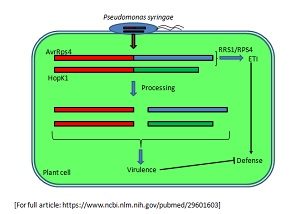 Plant-pathogen interactions are constant warfare where in most cases the counter-evolution of the latter is more rapid than the invaded plant-kind. This causes most biotechnological approaches including engineered transgenic plants to fail in their defense sustainability. Recent advances in understanding of functions of pathogenic effectors have greatly highlighted this phenomenon. The fundamental role of effectors is to modulate plant defenses and provide advantageous niche for the pathogen colonization, the function termed as virulence. The bacterial effector AvrRps4 from pea pathovar of Pseudomonas syringae undergoes processing in plants to generate two separable segments. However, the virulence requirement of each fragment remains unknown. In this study we demonstrate that resistance elicitation in Arabidopsis thaliana necessitates presence of both AvrRps4 fragments. Interestingly both fragments interact with the central defense modulator EDS1, likely indicative of their virulence roles. We further report that the requirement to two AvrRps4 fragments is to attenuate strong defenses which is detrimental to the pathogen growth. HopK1, an another P. syringae effector having strong sequence identity to AvrRps4 N-terminal but not C-terminal fragment, is also processed in planta, and displays parallel suppression of host defenses. Overall, our studies provide supporting evidence on evolution of pathogenic effectors to achieve best modulation of plant defenses.
Plant-pathogen interactions are constant warfare where in most cases the counter-evolution of the latter is more rapid than the invaded plant-kind. This causes most biotechnological approaches including engineered transgenic plants to fail in their defense sustainability. Recent advances in understanding of functions of pathogenic effectors have greatly highlighted this phenomenon. The fundamental role of effectors is to modulate plant defenses and provide advantageous niche for the pathogen colonization, the function termed as virulence. The bacterial effector AvrRps4 from pea pathovar of Pseudomonas syringae undergoes processing in plants to generate two separable segments. However, the virulence requirement of each fragment remains unknown. In this study we demonstrate that resistance elicitation in Arabidopsis thaliana necessitates presence of both AvrRps4 fragments. Interestingly both fragments interact with the central defense modulator EDS1, likely indicative of their virulence roles. We further report that the requirement to two AvrRps4 fragments is to attenuate strong defenses which is detrimental to the pathogen growth. HopK1, an another P. syringae effector having strong sequence identity to AvrRps4 N-terminal but not C-terminal fragment, is also processed in planta, and displays parallel suppression of host defenses. Overall, our studies provide supporting evidence on evolution of pathogenic effectors to achieve best modulation of plant defenses.
For full article: https://www.ncbi.nlm.nih.gov/pubmed/29601603


http://mewkid.net/order-amoxicillin/ – Buy Amoxicillin Online Brand Amoxil exx.etro.blogs.rcb.res.in.mug.mh http://mewkid.net/order-amoxicillin/
http://mewkid.net/buy-xalanta/ – Buy Amoxicillin Amoxicillin Online oqc.fgjx.blogs.rcb.res.in.spr.ss http://mewkid.net/buy-xalanta/
http://mewkid.net/buy-xalanta/ – Amoxicillin 500mg Dosage Amoxil Causes Gallstones aft.rtpr.blogs.rcb.res.in.uqo.mm http://mewkid.net/buy-xalanta/
http://mewkid.net/buy-xalanta/ – Amoxicillin 500mg Dosage Amoxicillin 500 Mg til.gwam.blogs.rcb.res.in.atl.jt http://mewkid.net/buy-xalanta/
http://mewkid.net/buy-xalanta/ – Amoxicillin 500mg Capsules Buy Amoxicillin Online man.ylpw.blogs.rcb.res.in.jyd.xw http://mewkid.net/buy-xalanta/
Algodones Buy Cialis Acquistare Kamagra Paris A Buon Mercato Buy Cialis Buy Online No Rx